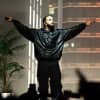About two-thirds of the way through his set on last year’s Jungle tour, Drake diverted from his hits to run through a quick cover of Sizzla’s “Just One Of Those Days (Dry Cry).” It’s one of the reggae artist’s most popular songs—Rihanna knows—and, by now, a staple of the genre. When “Dry Cry” came out in the early 2000s it would get played at every party in Toronto; like clockwork, just before the lights came up, the DJ would run the bouncy slowjam. Couples would magnetize, singles would line the walls, swaying on the downbeat, lighters up. It was a club staple at a time when Drake was still living in Toronto, listening to local radio, and partying in local spots, so even though his patois might make you cringe, his nostalgia was on brand.
For decades now, after passing a certain threshold of success most major U.S. pop stars go bilingual, tapping into the commercial power of Spanish-language markets at home and abroad. *NSYNC and Backstreet Boys reworked major singles, Beyonce put out an entire EP called Irremplazable, even Drake tried his hand at the Spanish-language single: In 2014, he and Romeo Santos made a play for each other’s markets with the collaborative track, “Odio.” Drake’s at the 10-year point in his career, but he still hasn’t landed a solo #1 single like Rihanna or Bey. And now the pervasiveness of a song, or an artist’s popularity, is no longer geofenced and language is becoming less and less of a barrier too. What songs like the percolating, UK funky-indebted “One Dance” and Popcaan-assisted dancehall banger “Controlla,” indicate is Drake’s understanding of major music markets around the world that are ripe for the picking. These are places where English might be the dominant language, but American pop or rap isn’t the coolest—or the most urgent—form.
This is a philosophy M.I.A. built her career on, and is certainly something Diplo is profiting from with Major Lazer and his production work for Justin Bieber—though Westerners are the intended audiences for these artists. On the major label level, artists like Kelly Rowland were making dance tracks for European markets well before EDM hit Stateside, to great success. Beyoncé’s been looking to Africa for sartorial, choreographic, and musical inspiration now for a minute, as she builds her global brand. And, as history continues to show, Akon did it first. Having immigrated to the U.S. from Senegal, he was primed to understand the power of the global market.
Views From The 6 is positioned as Drake’s Toronto record, but a lot of what he’s put out in the past year—including his involvement with Rihanna’s “Work”—is indebted to sounds that originate in the British underground and Caribbean. People from those parts of the world make up the Toronto citizenry and have a stake in the city’s culture, but that isn’t necessarily indicative of a commercial presence for these sounds in the local industry. First- and second-generation Canadians are contributing to a local arts scene, but the “Toronto sound” has shifted toward more market-friendly rap and R&B since Jamaican-Canadians like Kardinal Offishall and Choclair were on top. Kardi was known for pushing a dancehall delivery and even K’naan mixed Somali references into his sound.
Caribana and Afrofest, two annual summer events that are showcases for West Indian and African rhythms, have been marginalized by the city and public at various points of their respective histories. Commercial radio is a dead end when it comes to representing any local urban identity. For the most part, Toronto’s sellable cultural diversity begins, and ends, within the food scene—and even then the most successful chefs and restaurateurs are white. Afrobeats, dancehall, and progressive dance music have a presence here, but the party scenes are siloed. You’re more likely to hear the Crazy Cousinz and Kyla track that “One Dance” samples at an old head house music party faster than you’d hear it where the cool kids roam. You might say that Drake’s new polyglot sound has developed in a sonic vacuum, and he’s using his civic identity—as the torchbearer of the multicultural city of Toronto—to play with, even appropriate, styles that are bubbling (or are well-established!) in urban centres around the world. It’s an exaggerated multiculturalism; one FADER editor even likens the performance to drag.
In last year’s FADER cover story on Drake, writer Leon Neyfakh called all of this—Drake’s dabblings with Popcaan and Skepta and WizKid, and his interest in elevating Toronto’s immigrant-enabled slang—the mounting of a “global tentpole brand,” which is an accurate assessment. That impulse has been on display since No I.D. cooked up that brutalist dembow for “Find Your Love.” While growing up in a city with a diverse populace might have helped Drake become the kind of pop star that can code switch on a global level, London, Kingston, Port-Of-Spain, Lagos, should get the credit for the sound before Toronto does.


